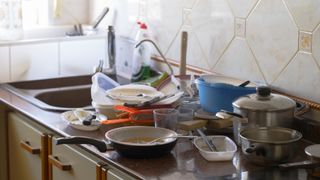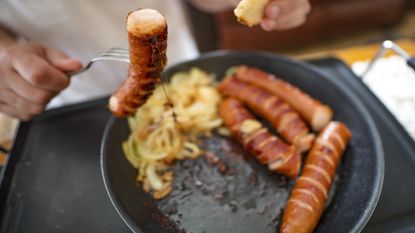Are non-stick pans safe? The answer is more complicated than it probably needs to be, but don't worry: we will tell you all you need to know here.
What's for sure is that the best non-stick pans are certainly convenient, and hugely popular. In our guide to how to care for non-stick pans, you'll find there are some fairly easy ways to make any pan – cast iron, steel, aluminium – non-stick, and last for longer. However a classic non-stick pan is still most people's first choice.
Despite that, we know that a lot of people have concerns about the safety of non-stick materials.
Are non-stick pans safe?

This is the burning question, but first, a bit of background. When Teflon first arrived in the 1940s it revolutionised home cooking, but that revolution came at a price.
Teflon was made using a chemical called perfluorooctonoic acid (PFOA), but in more recent years PFOA – and indeed other perfluorinated alkyl substances (PFAS) – have been found to be damaging to humans, animals and the environment.
Medical studies have found PFOA causes a worrying array of illnesses, dysfunctions and disorders, including cancer. PFAS also take thousands of years to break down, so they remain in our systems and in the environment.
PFOA: NOT safe
As a result of the damage caused by PFOA, it has been banned in the US, UK, and many other countries. Any non-stick pans you see today will not contain PFOA unless they were manufactured many years ago.
However, many other PFAS remain legal in the UK and elsewhere. Some argue that we know just as much about other PFAS as we did about PFOA before 2015, and they all carry the same environmental issue, which is that once created, we have no way of destroying them.
So, is PTFE safe?
When used within the parameters it is designed for, there is no reason currently to think it is not safe. But it always pays to do your own research and make up your own mind on such things.
• Read an excellent investigative piece on PFOA at the New York Times.
Non-stick pans: the safest alternatives

Ceramic non-stick
This uses a layer of a silicone-based coating and is the most eco-friendly alternative to PTFE that we have. It doesn't have quite the same, near-miraculous non-stick qualities as PTFE, but it is a very slippery customer.
With the difference in performance between PTFE and ceramic being minimal in most cases, the big difference with ceramic non-stick is that it's free of all PFAS.
Steel and cast iron pans
It's also worth considering a pan with no non-stick surface on at all. Why? Because you can make it non-stick, to a surprising extent, by seasoning and care.
Seasoning involves building up a layer of polymerised oil on your pan. This protects the metal – particularly essential for case iron as it can actually rust – and adds a 'non-stick' surface. No, not as non-stick as a layer of ceramic or PTFE, but good enough for most purposes other than very sticky foods such as eggs.
To season a pan, heat it up with a layer of oil inside. The oil should high a smoke point – flax seed and grapeseed (peanut) oil are popular. The oil needs to be heated in the oven or on the hob – or a combination of the two – to around 200ºC. It's usually necessary to do this several times, as well.
Once seasoned it's also a good idea to wipe the surface of the pan with a very thin layer of oil after each use.
For users of more traditional types of non-stick pans this may sound like an incredible amount of hassle, but it's really not. The main benefit here is that once properly seasoned, your steel or cast iron pan should last a lifetime and become increasingly 'non-stick' over time. Even the very best non-stick pan of the standard, coated type is unlikely to last more than 5 years.
Caring for your non-stick pans

We have an entire guide to buying and caring for pans but here is the short version.
• Use non-stick pans only on a low heat
If you have an induction hob, resist the urge to use that very handy turbo heating setting – or if you can't resist, please at least only use it for a very short initial burst to get your pan up to temp.
• Don't use metal utensils
Even if the pan maker says you can.
• Allow non-stick pans to cool before cleaning
Never put a hot, non-stick pan into a sink of cold water.
• Don't use a dishwasher
Even if the pan maker says you can!
• Don't store pans stacked inside one another
Or, if you can't avoid that for reasons of space, at least line them with tea towels.
Speaking of tea towels, the inside of a good non-stick pan should be cleanable just by wiping it with one, or something else similarly absorbent.
Follow those simple rules and you'll maximise the life-span of your non-stick pan, and also reduce the risk of releasing any chemical unpleasantness into your dinner.


